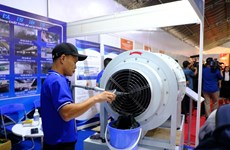Renewables to supply 5 percent of nation’s energy
Vietnam can generate 2,400 MW per year
from renewable sources by 2020, or 5 percent of the total electricity
production in the country, experts have said.
Vietnam can generate 2,400 MW per year
from renewable sources by 2020, or 5 percent of the total electricity
production in the country, experts have said.
However, this will need significant start-up capital assistance from the Government, they add.
“The percentage of electricity generated from renewable energy sources will depend on the funds made available from the State budget for this sector,” said Le Tuan Phong, deputy director of the Ministry of Industrial and Trade’s Energy Department.
Phong, who heads the ministry’s renewable energy committee, said the sector would focus on developing small-scale hydro-power plants, wind and solar energy, as well as biogas projects.
The ministry had submitted to the Government a master plan for the development of renewable energy, including strategies, incentive policies and regulations to encourage the development of this sector, he said.
Vu Dinh Tuan, CEO of the German-Vietnamese Fuhrlaender Vietnam Wind Power Joint Stock Company, said the incentive policies for businesses investing in clean energy were not focused or detailed enough, and had been applied differently in various localities.
He said there was high potential for developing wind energy in Vietnam , “but this sector requires much more capital.”
The American True Wind Solution Organisation has said that Vietnam has the highest potential for generating wind energy among Laos, Cambodia and Thailand.
Tuan said the Government should create favourable conditions for the renewable energy to develop, including rapid approval of land grants, pricing policies for alternate energy and permission for different sectors to get involved.
While there are several wind energy projects in the pipeline in the provinces of Binh Dinh, Lam Dong, Ninh Thuan, only the last-mentioned has come up with detailed development plans.
The Fuhrlaender Vietnam Company is planning to build a 25 million USD factory for installing wind power turbines, which has already been approved by Binh Thuan authorities./.
However, this will need significant start-up capital assistance from the Government, they add.
“The percentage of electricity generated from renewable energy sources will depend on the funds made available from the State budget for this sector,” said Le Tuan Phong, deputy director of the Ministry of Industrial and Trade’s Energy Department.
Phong, who heads the ministry’s renewable energy committee, said the sector would focus on developing small-scale hydro-power plants, wind and solar energy, as well as biogas projects.
The ministry had submitted to the Government a master plan for the development of renewable energy, including strategies, incentive policies and regulations to encourage the development of this sector, he said.
Vu Dinh Tuan, CEO of the German-Vietnamese Fuhrlaender Vietnam Wind Power Joint Stock Company, said the incentive policies for businesses investing in clean energy were not focused or detailed enough, and had been applied differently in various localities.
He said there was high potential for developing wind energy in Vietnam , “but this sector requires much more capital.”
The American True Wind Solution Organisation has said that Vietnam has the highest potential for generating wind energy among Laos, Cambodia and Thailand.
Tuan said the Government should create favourable conditions for the renewable energy to develop, including rapid approval of land grants, pricing policies for alternate energy and permission for different sectors to get involved.
While there are several wind energy projects in the pipeline in the provinces of Binh Dinh, Lam Dong, Ninh Thuan, only the last-mentioned has come up with detailed development plans.
The Fuhrlaender Vietnam Company is planning to build a 25 million USD factory for installing wind power turbines, which has already been approved by Binh Thuan authorities./.













